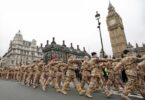Nic Robertson
On the day Vladimir Putin issued an order to build museums across Russia to commemorate his country’s war in Ukraine, another very different kind of monument to the conflict’s cruel brutality was created by his forces in the city of Uman, 210 km south of Kyiv. In the early hours of Friday, as civilians slept, a Russian Kh-101 cruise missile soared above the Ukrainian countryside.
Far below, in a complex of some 46 apartments, a resident heard the missile’s distinctive “whooshing” sound as it headed toward her building. Grabbing her children, she threw them into a bathtub and covered them with pillows and a blanket. Then, she told us, she just waited and hoped they would see the morning.
In the event, she and her family were among the lucky ones. When the missile slammed into the complex, its ferocious blast tore through 27 of the apartments. Floors collapsed, rubble tumbled to the ground and, in an instant, as has happened so often in this war, dozens of innocent lives were ripped apart. We spoke to a man who was among the first on the scene. He could hear the screams of children when he arrived, he told us. He saw a woman trapped under rubble and, with help from others, managed to somehow free her and get her into an ambulance. But it was too late – she later succumbed to her injuries in hospital.
As the day wore on, a cluster of firefighters and other rescue workers encircled the still-smoldering base of the complex. A few meters away from them, a group of residents, relatives and friends stood in a line, anxiously awaiting news of the missing. Diggers lifted the larger chunks of concrete, while workers picked through the rubble by hand. Up above them, on the eighth floor of the shattered building, had lived a family of four. The mother had escaped, a resident told me through agonized tears, and the father was in hospital; but their two daughters, aged seven and 13, were still missing, she explained. It was impossible not to fear the worst.
Throughout the day, more bodies were pulled from the wreckage. By late afternoon, the death toll had risen to at least 23, including four children, and 18 injured. With a total of 109 people registered as living in the building, that grim toll was expected to rise. Russia had fired 23 missiles into Ukraine that night. Twenty-one of them had been intercepted, but the scene in Uman showed the tragic consequences of just one making it through. This is already the deadliest single strike on civilians since January of this year. Russia denies that it is targeting civilians with its missiles, but the evidence strongly suggests otherwise. The museums the Kremlin announced last week will showcase “the events of the special military operation and the heroic deeds of its participants.” One wonders what the Russian public would make of deeds such as the one perpetrated here, if only they were allowed to see them.







